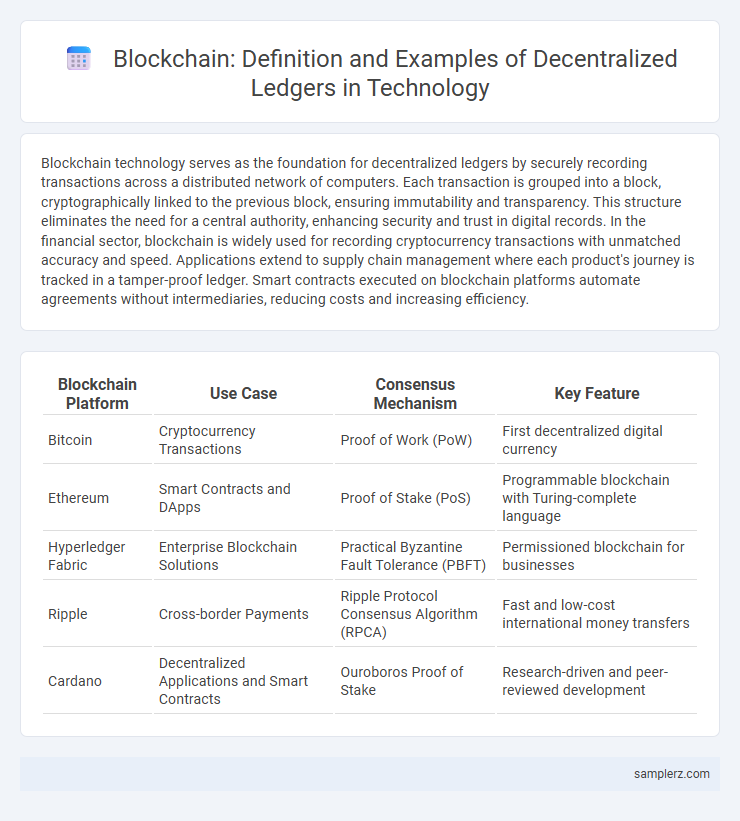Blockchain technology serves as the foundation for decentralized ledgers by securely recording transactions across a distributed network of computers. Each transaction is grouped into a block, cryptographically linked to the previous block, ensuring immutability and transparency. This structure eliminates the need for a central authority, enhancing security and trust in digital records. In the financial sector, blockchain is widely used for recording cryptocurrency transactions with unmatched accuracy and speed. Applications extend to supply chain management where each product's journey is tracked in a tamper-proof ledger. Smart contracts executed on blockchain platforms automate agreements without intermediaries, reducing costs and increasing efficiency.
Table of Comparison
| Blockchain Platform | Use Case | Consensus Mechanism | Key Feature |
|---|---|---|---|
| Bitcoin | Cryptocurrency Transactions | Proof of Work (PoW) | First decentralized digital currency |
| Ethereum | Smart Contracts and DApps | Proof of Stake (PoS) | Programmable blockchain with Turing-complete language |
| Hyperledger Fabric | Enterprise Blockchain Solutions | Practical Byzantine Fault Tolerance (PBFT) | Permissioned blockchain for businesses |
| Ripple | Cross-border Payments | Ripple Protocol Consensus Algorithm (RPCA) | Fast and low-cost international money transfers |
| Cardano | Decentralized Applications and Smart Contracts | Ouroboros Proof of Stake | Research-driven and peer-reviewed development |
Introduction to Blockchain and Decentralized Ledgers
Blockchain technology underpins decentralized ledgers by enabling secure and transparent record-keeping across multiple nodes without a central authority. Each block contains a cryptographic hash of the previous block, transaction data, and a timestamp, ensuring immutability and consensus through protocols like Proof of Work or Proof of Stake. Prominent examples include Bitcoin and Ethereum, which utilize decentralized ledgers to facilitate peer-to-peer transactions and smart contracts.
Key Features of Decentralized Ledger Technology
Decentralized ledger technology (DLT) enables secure, transparent, and immutable record-keeping across multiple nodes without a central authority, exemplified by blockchain platforms like Ethereum and Hyperledger Fabric. Key features include consensus mechanisms such as Proof of Work and Proof of Stake that validate transactions, cryptographic hashing ensuring data integrity, and smart contracts automating trust and execution of agreements. These properties facilitate enhanced security, reduced fraud risk, and increased transparency in industries ranging from finance to supply chain management.
Blockchain Use Case: Cryptocurrency Transactions
Blockchain technology underpins cryptocurrency transactions by providing a decentralized ledger that ensures transparency, security, and immutability. Bitcoin and Ethereum utilize blockchain to facilitate peer-to-peer payments without intermediaries, reducing transaction fees and settlement times. This use case demonstrates blockchain's capacity to enhance financial systems by enabling secure, trustless, and efficient digital asset transfers.
Blockchain in Supply Chain Management
Blockchain in supply chain management enhances transparency by providing an immutable decentralized ledger that tracks every transaction from origin to delivery. This technology reduces fraud and errors, optimizes inventory management, and improves traceability by enabling real-time access to verified data across multiple stakeholders. Companies like IBM and Maersk utilize blockchain to streamline logistics, increase security, and ensure product authenticity throughout global supply chains.
Decentralized Identity Verification with Blockchain
Decentralized Identity Verification with blockchain leverages cryptographic algorithms to create secure, tamper-proof digital identities stored on distributed ledgers. Platforms like Sovrin and uPort enable individuals to control their personal data without centralized intermediaries, enhancing privacy and reducing identity theft risks. This method improves trust and transparency by allowing verifiable credentials to be shared selectively and in real-time across multiple parties.
Blockchain-Powered Smart Contracts
Blockchain-powered smart contracts automate and enforce agreements through decentralized ledger technology, ensuring transparency and security without intermediaries. These smart contracts execute predefined conditions automatically, reducing fraud and increasing efficiency in industries such as finance, real estate, and supply chain management. Platforms like Ethereum leverage blockchain to facilitate trustless transactions, enabling programmable contracts that are immutable and auditable on the distributed ledger.
Blockchain Applications in Healthcare Data Management
Blockchain technology enables secure, transparent management of healthcare data by creating decentralized ledgers that verify patient records in real time, reducing errors and fraud. Applications include electronic health records (EHR) systems where blockchain ensures data immutability and patient privacy through cryptographic encryption. Smart contracts automate consent management, streamlining data sharing among providers while maintaining compliance with regulations like HIPAA.
Blockchain for Decentralized Voting Systems
Blockchain technology enhances decentralized voting systems by providing secure, transparent, and tamper-proof ledgers that record votes in real-time. Ethereum and Hyperledger Fabric are prominent platforms used to implement smart contracts that automate vote tallying and verification. This innovation significantly reduces fraud risks and increases trust in electoral processes through immutable data records and cryptographic security.
Blockchain in Digital Asset Ownership and NFTs
Blockchain technology underpins digital asset ownership by ensuring secure, transparent, and immutable recording of transactions on decentralized ledgers. Non-fungible tokens (NFTs) exemplify this application, enabling unique digital assets such as art, music, and collectibles to be verifiably owned and traded. This decentralized verification eliminates intermediaries, reducing fraud and enhancing provenance in digital marketplaces.
Future Prospects of Blockchain in Decentralized Ledgers
Blockchain technology's future prospects in decentralized ledgers include enhanced scalability through sharding and layer-two solutions, which address current transaction speed limitations. Integration with Internet of Things (IoT) devices promises secure, automated data exchanges across distributed networks, improving transparency and trust. Emerging consensus algorithms like Proof of Stake (PoS) and Practical Byzantine Fault Tolerance (PBFT) are set to increase energy efficiency and transaction finality in blockchain-based decentralized ledgers.

example of blockchain in decentralized ledger Infographic
 samplerz.com
samplerz.com